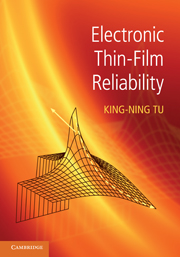Book contents
- Frontmatter
- Dedication
- Contents
- Preface
- 1 Thin-film applications to microelectronic technology
- 2 Thin-film deposition
- 3 Surface energies
- 4 Atomic diffusion in solids
- 5 Applications of the diffusion equation
- 6 Elastic stress and strain in thin films
- 7 Surface kinetic processes on thin films
- 8 Interdiffusion and reaction in thin films
- 9 Grain-boundary diffusion
- 10 Irreversible processes in interconnect and packaging technology
- 11 Electromigration in metals
- 12 Electromigration-induced failure in Al and Cu interconnects
- 13 Thermomigration
- 14 Stress migration in thin films
- 15 Reliability science and analysis
- Appendix A A brief review of thermodynamic functions
- Appendix B Defect concentration in solids
- Appendix C Derivation of Huntington's electron wind force
- Appendix D Elastic constants tables and conversions
- Appendix E Terrace size distribution in Si MBE
- Appendix F Interdiffusion coefficient
- Appendix G Tables of physical properties
- Index
- References
7 - Surface kinetic processes on thin films
Published online by Cambridge University Press: 05 July 2014
- Frontmatter
- Dedication
- Contents
- Preface
- 1 Thin-film applications to microelectronic technology
- 2 Thin-film deposition
- 3 Surface energies
- 4 Atomic diffusion in solids
- 5 Applications of the diffusion equation
- 6 Elastic stress and strain in thin films
- 7 Surface kinetic processes on thin films
- 8 Interdiffusion and reaction in thin films
- 9 Grain-boundary diffusion
- 10 Irreversible processes in interconnect and packaging technology
- 11 Electromigration in metals
- 12 Electromigration-induced failure in Al and Cu interconnects
- 13 Thermomigration
- 14 Stress migration in thin films
- 15 Reliability science and analysis
- Appendix A A brief review of thermodynamic functions
- Appendix B Defect concentration in solids
- Appendix C Derivation of Huntington's electron wind force
- Appendix D Elastic constants tables and conversions
- Appendix E Terrace size distribution in Si MBE
- Appendix F Interdiffusion coefficient
- Appendix G Tables of physical properties
- Index
- References
Summary
Introduction
Surface kinetic processes deal with nucleation, growth, and ripening processes on a surface from the point of view of atomic absorption, desorption, and diffusion on the surface. The surface of a thin film, more specifically the surface of a single crystal, is the starting place for these processes. The single-crystal surface has a microscopic structure associated with crystallographic structure and symmetry and reconstruction, as well as a macroscopic structure associated with surface steps, kinks, and other surface defects [1–4]. Surface chemical reaction such as oxidation is not considered here.
In Chapter 3, there was a brief discussion of surface crystallographic structure. A ball-and-stick crystal model could depict a (100) surface of silicon, the cubic face of a diamond lattice, as a portion of a plane of infinite extent consisting of a square array of atoms. Each of these atoms has two unpaired electron bonds. On a (100) surface of silicon, the atoms displace laterally (as shown schematically in Fig. 3.12) to satisfy the bonding requirement. Such surfaces are called “reconstructed.”
On a larger scale, single-crystal surfaces can contain terraces, steps, kinks, and other defects. As shown in Fig. 7.1, the step spacing is associated with the miscut of the crystal. The miscut angle is the angular difference between a crystal plane and the mechanical surface of the crystal established when an ingot is cut. Under production conditions this angle is about 0.1°. The relationship shown in the figure relates the step spacing L0 to the miscut angle.
- Type
- Chapter
- Information
- Electronic Thin-Film Reliability , pp. 141 - 169Publisher: Cambridge University PressPrint publication year: 2010



